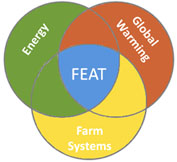About FEAT
The Farm Energy Analysis Tool (FEAT)is a static, deterministic, data-base model, was created to use a whole-farm approach to evaluate energy and greenhouse gas (GHG) emissions for different agricultural systems. This simple, yet effective, computer modeling approach allows for a rapid evaluation which provided useful estimates needed for agricultural researchers.
The energy required to grow a crop can be calculated by accounting for energy associated with required inputs and then converting inputs to a same unit of energy (MJ), which creates an analytical coherence and flexibility that is very practical for evaluating systems (Farrell et al., 2006; Pimentel & Patzek, 2005). The methodology for GHG evaluation is similar to energy analysis, where all the inputs and outputs are converted to one mass unit of carbon equivalent or carbon dioxide equivalent (CO2e) (Farrell, et al., 2006; Lal, 2004). The main GHGs from agricultural production (CO2, CH4, and N2O) (Kim & Dale, 2005; Robertson, Paul, & Harwood, 2000) have different global warming potentials (GWP); in other words, each GHG has a different impact in terms of global warming, and GWP is used as a factor to equalize each gas, usually calculated over a 100 year timeframe (IPCC, 2006). After GWP conversion, GHGs can be added since they have the units of kilograms of carbon dioxide equivalent (CO2e) (Chianese, Rotz, & Richard, 2009). The Farm Energy Analysis Tool (FEAT) is database model that organizes information from the literature in a functional and transparent model that can be used to estimate energy use and GHG emissions from crop production (Appendix A). The model currently includes the following crops: 1) barley (Hordeum vulgare L.) harvested for grain; 2) corn harvested for grain and silage; 3) rye (Secale cereale L.) harvested for silage; 4) wheat (Triticum aestivum L.) harvested for grain and silage; 5) alfalfa (Medicago sativa L.); 6) red clover (Trifolium pratense L.); 7) canola (Brassicanapus L.); 8) soybean; 9) sugar beet (Beta vulgaris L.); 10) miscanthus (Miscanthus × giganteus Greef et Deu.); 11) switchgrass (Panicum virgatum L.); 12) hybrid poplar (Populus spp.); and 13) willow (Salix spp.).
The model also has worksheets for calculating green- and animal-manure fertilizer credits and for importing feed crops.
If you have questions, comments, or corrections please submit to FEAT
